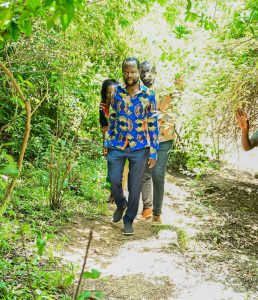Kisumu Governor Professor Peter Anyang’ Nyong’o visited Got Ramogi in Siaya County, becoming the latest high-profile figure to explore the cultural site.
His visit followed the Piny Luo Cultural Festival, which had kicked off on Tuesday, December 31, and highlighted the rich heritage of the Luo community from both Kenya and Uganda.
The second day of the festival featured exciting events, including water-based sports and wrestling, attracting a large local crowd.
The event was officially opened by former Prime Minister Raila Odinga at the Migwena Cultural Grounds in Siaya, and attended by several local governors.
The celebration was an opportunity for thousands of attendees to gather and celebrate their shared cultural roots.

Got Ramogi, a revered hill in the Luo community, holds immense historical and cultural importance. Governor Nyong’o, expressing his deep connection to the site, explained its significance.
“Got Ramogi is not just a hill; it is a symbol of our shared history and the stories that connect us to our past,” he wrote on social media.
The hill is traditionally recognized as the first settlement point of the Luo people after their migration from South Sudan through Uganda.
It marks the beginning of their journey and serves as a tangible link to their ancestors.
Governor Nyong’o reflected on the visit, saying, “Today, I had the privilege of visiting Got Ramogi, a site that holds deep historical and cultural significance for our community.
Standing on this sacred ground, I was reminded of the strength, resilience, and unity of our ancestors who laid the foundation for our identity and heritage.”
Got Ramogi is closely tied to the figure of Ramogi Ajwang’, revered as the father of the Luo nation.
This figure symbolizes leadership, unity, and the ancestral legacy of the Luo people.

The hill, beyond its geographic importance, is also a cultural repository that embodies traditions, rituals, and beliefs central to Luo identity.
The area is home to numerous cultural sites and shrines (hembko), which hold spiritual significance for the community.
Rituals performed at these sites often involve offerings to Nyasaye (God), seeking blessings and prosperity.
These practices reflect the deep spiritual connection the Luo people have with their ancestors and the natural world.
The hill also carries rich mythology, with local beliefs suggesting that Ramogi himself can be encountered at certain points on the hill.
One of the most famous landmarks, the Rapogi Stone, is said to have been used by Ramogi as an altar during times of drought.
Besides its historical and spiritual importance, Got Ramogi is also known for its biodiversity, attracting nature enthusiasts with its unique flora and fauna.
Today, the hill stands not only as a cultural and spiritual symbol but also as a potential hub for tourism, drawing attention to the Luo community’s heritage and the broader historical and ecological landscape of the region.
Email your news TIPS to Editor@NairobiNews.co.ke
